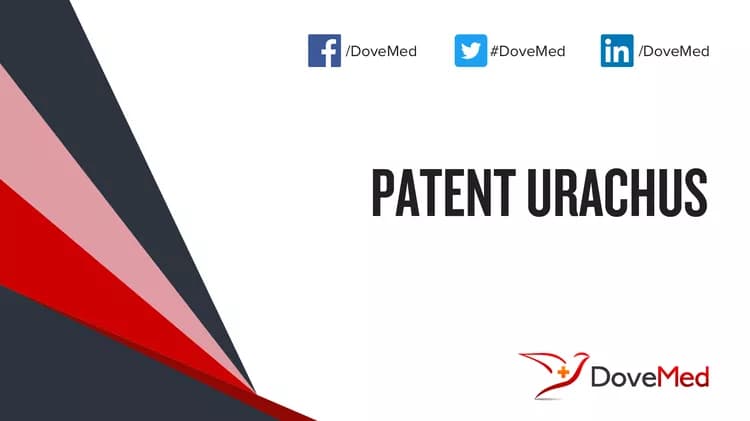What are the other Names for this Condition? (Also known as/Synonyms)
- Persistent Urachus
- Urachal Fistula
What is Patent Urachus? (Definition/Background Information)
- The urachus is a tubular structure that forms during early fetal development. This structure connects the anterior portion (anterior bone) of the urinary bladder to the umbilicus. Usually, the urachus closes by week 12 of gestation, leaving behind a thick fibrous band. However, rarely, some portions of the urachus may not close completely, resulting in a variety of urachal abnormalities
- Although the urachus normally disappears prior to birth, it may remain patent or open in some cases. This form of urachal abnormality is termed Patent Urachus. The condition is commonly diagnosed earlier in life (almost immediately after birth), given the obvious clinical findings of constant leakage of urine from the umbilicus
- Patent Urachus may result in chronic dermatitis of skin around the umbilical cord; it also has a potential for recurrent urinary tract infections. Sometimes, the abnormality is associated with posterior urethral valves, in which the Patent Urachus may be the only pathway for the urine to flow out
- Patent Urachus is generally surgically resected, either through an open approach or a laparoscopy. A laparoscopic approach is better suited as it prevents recurrent urinary tract infections and there is no umbilical skin breakdown
- The prognosis of children with isolated urachal anomalies (i.e., not associated with any other congenital conditions) is typically good with treatment. Following a surgical removal of the urachal remnants, the outcome of Patent Urachus is usually excellent
There are five forms of congenital urachal remnant abnormalities, and these include:
- Alternating sinus of urachus (some experts recognize this as a type of umbilical-urachal sinus)
- Patent Urachus
- Umbilical-urachal sinus
- Urachal cyst
- Vesicourachal diverticulum
Among these urachal abnormalities, Patent Urachus is the only condition that predominantly presents symptoms following birth of the child (early infancy).
Who gets Patent Urachus? (Age and Sex Distribution)
- The incidence of urachal anomalies among the pediatric population is about 1.03%. True Patent Urachus is rare and represents only 1.5% of the urachal anomalies
- According to literature, Patent Urachus constitutes between 10 to 48% of all congenital urachal abnormalities
- It can occur both in female and male children, but the incidence in boys is three times higher than in girls
- No specific racial or ethnic group predilection is noted
What are the Risk Factors for Patent Urachus? (Predisposing Factors)
- Currently, no risk factors have been clearly identified for the formation of Patent Urachus
- 25-30% of children with prune belly syndrome are known to have Patent Urachus
It is important to note that having a risk factor does not mean that one will get the condition. A risk factor increases one’s chances of getting a condition compared to an individual without the risk factors. Some risk factors are more important than others.
Also, not having a risk factor does not mean that an individual will not get the condition. It is always important to discuss the effect of risk factors with your healthcare provider.
What are the Causes of Patent Urachus? (Etiology)
Before birth, the urachus is a primitive structure that connects the umbilical cord to the bladder in the developing baby. The urachus helps in removal of nitrogenous wastes from the fetus through the placenta via the umbilical cord. The remnant fibrous band of urachus is called the medial umbilical ligament.
- The urachus is generally between 3-10 cm in length and 1 cm in diameter. When the urachus disappears normally around the 12th week of fetal development, a small fibrous cord (median umbilical ligament) remains between the bladder and the umbilicus
- The urachus normally disappears before birth, but occasionally, the urachus may remain patent/open after the child is born. This can lead to urachal abnormalities such as Patent Urachus. The exact reason why this occurs is unknown
True Patent Urachus is an uncommon form of urachal anomaly. Less than 1 in 65 urachal abnormalities are diagnosed as true Patent Urachus.
What are the Signs and Symptoms of Patent Urachus?
Patent Urachus is commonly diagnosed at birth due to the presentation of symptoms. Predominantly, it is associated with leakage of urine from the umbilicus. In newborn babies and infants, there is wetness around the belly button that is persistent. Because of the wetness, the umbilical cord stump often does not heal, resulting in a persistent skin redness.
The other signs and symptoms of the condition vary, but may include:
- Lower abdominal pain
- Fever, due to infection
- Presence of an abdominal lump or mass
- If it is associated with urinary tract infections, then the following signs and symptoms may be noted:
- Changes in urination frequency
- Burning sensation or pain during urination
- Fever and chills
- Changes in urine smell and color
- Sometimes, pain during sexual intercourse
In some children, the condition is asymptomatic. When Patent Urachus is asymptomatic, it is usually detected incidentally on ultrasound scans that are performed for other medical conditions.
How is Patent Urachus Diagnosed?
The diagnosis of Patent Urachus may be suspected based on the presence of characteristic signs and symptoms (such as persistent wetness around in the umbilicus in a child). The following tests may then be ordered to confirm the diagnosis:
- Physical examination and evaluation of medical history
- Ultrasound studies: Prenatal abdominal ultrasound may reveal associated fetal abnormalities, if any
- A voiding cystourethrogram (VCUG) is performed to look for urinary tract abnormalities such as posterior urethral valves
- Sinogram: A contrast dye is injected into the umbilicus in order to check for Patent Urachus
- Computed tomography (CT scan) or magnetic resonance imaging (MRI scan) of the affected region, if necessary
According to a particular case study (among pediatric autopsies), an incidence of 1 in 7,610 was reported for Patent Urachus.
Many clinical conditions may have similar signs and symptoms. Your healthcare provider may perform additional tests to rule out other clinical conditions to arrive at a definitive diagnosis.
What are the possible Complications of Patent Urachus?
- The complications of Patent Urachus include higher risks for recurrent urinary tract and umbilical infections
- There is a small risk for urachal cancer; and in such cases, the entire urachus may be surgically removed
Complications may occur with or without treatment, and in some cases, due to treatment also.
How is Patent Urachus Treated?
- Patent Urachus is generally surgically resected by either open surgery or a laparoscopic approach
- In order to prevent recurrent urinary tract infections and breakdown of umbilical skin, a laparoscopic approach is preferred
- If there is an infection associated with Patent Urachus, then the infection is treated prior to any surgical corrections are undertaken
How can Patent Urachus be Prevented?
Presently, Patent Urachus may not be preventable, since it is a congenital condition.
- Active research is currently being performed to explore the possibilities for treatment and prevention of such conditions
- A careful and periodic monitoring of the pregnancy is advised and recommended
What is the Prognosis of Patent Urachus? (Outcomes/Resolutions)
- The prognosis for Patent Urachus in isolation is generally good with appropriate treatment
- A surgical removal of the urachal remnant in symptomatic cases can result in a cure
- However, the presence of posterior urethral valves should be excluded and treated accordingly
Additional and Relevant Useful Information for Patent Urachus:
The following DoveMed website link is a useful resource for additional information:
Related Articles
Test Your Knowledge
Asked by users
Related Centers
Related Specialties
Related Physicians
Related Procedures
Related Resources
Join DoveHubs
and connect with fellow professionals



0 Comments
Please log in to post a comment.